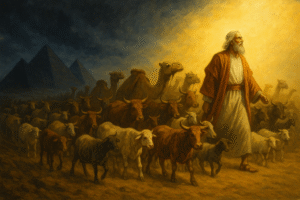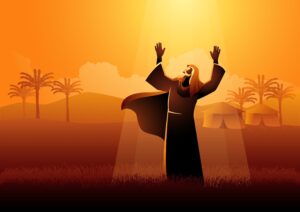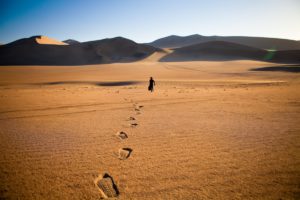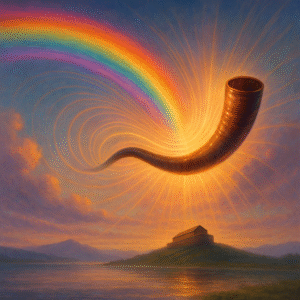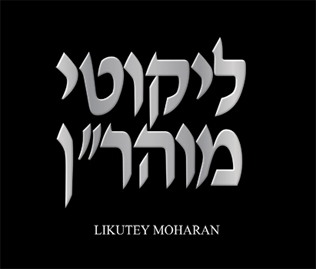- Faith ⬦ Read ⬦ Shabbat ⬦ Weekly Torah Portion
How Will We Know Who to Bring Close? – Parshat Vayakhel
Every person is obligated to bring others closer to the Creator, but how do we know who to bring close and who not? This is the subject of this week’s parsha lesson.
This week’s Torah portion is Parshat Vayakhel. In the parsha, Moses gathers the people to teach them about the terumah (contribution to) and the construction of the Mishkan. But before this, he warned them about observing the laws of Shabbat: “Six days work may be done, but the seventh day you shall sanctify, a day of complete rest to the L-rd; whoever performs work thereon [on this day] shall be put to death. You shall not kindle fire in any of your dwelling places on the Sabbath day” (Exodus 35:2-3).
There are two perplexing things in this parsha. First, what is the connection between being careful to keep the laws of Shabbat and the construction of the Mishkan (Tabernacle)? Second, if it is forbidden to do any work on Shabbat, why did the Torah need to point out that it is forbidden to light a fire on Shabbat? Our Sages explained: “He [Moses] prefaced [the discussion of the details of] the construction of the Mishkan with the warning to keep the Sabbath, denoting that it [i.e., the building of the Mishkan] does not override the Sabbath” (Rashi). And regarding the necessity to enumerate separately the prohibition of lighting a fire on Shabbat, our Sages taught that either it is to teach that it is just a regular prohibition as opposed to other types of labor on Shabbat, for which one gets capital punishment, or it was singled out to divide the various labors, i.e., to establish liability for capital punishment for each and every one of them (Sanhedrin 35b).
Either way, we know that there is no mitzvah that cancels the laws of Shabbat except for mitzvot that must be done at a set time, for example, brit milah (circumcision). The Torah designates this mitzvah for the eighth day after the birth of a male child. It doesn’t matter which day of the week the eighth day falls out on, and therefore, we perform a brit milah even on Shabbat. However, the work of building the Mishkan is not considered a melachah that is time-dependent, so why should we think that we might have to desecrate Shabbat in order to build it? Why then was it necessary to warn us that it would not push off the laws of Shabbat?
To understand this, we will learn a wonderful idea that sheds light on this issue:
Every Jew has a duty to bring people closer to the Creator, no matter who they are. Each person has his own good point which he can share with another person to help him draw closer to the Creator. When a person brings people closer to the Creator, he builds the “Heichal HaKodesh.” The word “kodesh” (holiness) refers to people coming closer to perfect yirah (fear and awe of G-d) and holiness. The word “Heichal” refers to honor, as it says in the verse: ” in His Heichal/Temple everyone speaks of His glory” (Psalms 29:9). The Creator is honored when those who are far away from Him come closer to Him.
However, when a person draws others closer, it can happen (G-d forbid) that the evil in those who are in the process of drawing closer to G-d will grab hold of him and will knock him down from the levels he has achieved. The advice for this is that the person should judge his actions well, and he should uproot the evil from within himself, and through this, his heart will burn to come close to G-d. And this fire will then burn and consume the evil of those he is bringing closer so that it will not be able to get a grip on him. This process, in which the power of evil is consumed through one judging himself, is the same as observing the Shabbat, which, as is known, eliminates the evil that clings to the six days of the week (as mentioned in the Zohar: “You shall keep My Shabbatot, which is a circle with a square inside it” (Likutei Moharan I, 59). Through the circle and the square within it, the forces of evil are nullified, and the holiness of Shabbat is protected. Rebbe Nachman equates the circle to a chair as in the verse: “the top of the throne was circular” (Kings I, 10:19), and it is known that a chair is an expression of honor, as, it is said: “Kisei HaKavod,” the Throne of Honor. The square is equated to the judgment that a person judges himself, as in the verse: “It shall be square and folded over double,” which refers to the Choshen HaMishpat, the breastplate (Exodus 28:16).
The work of building the Mishkan is not considered a melachah that is time-dependent, so why should we think that we might have to desecrate Shabbat in order to build it?
With reference to what we have mentioned above, Rabbi Natan clarifies this subject in connection to our parsha in a wondrous way: the work of the building of the Mishkan and its vessels is essentially the same work as bringing people closer to the Creator. According to the way that the Mishkan was erected, the physical structure whose main purpose was for the Heichal (sanctuary) which was before the Kaporet, which was the place of the Aron (Ark), where the Shechina dwelled. So too with regard to spirituality, the Heichal HaKadosh, the Holy Sanctuary, was built by Moses, bringing everyone closer and bringing them back in teshuvah (repentance), and thereby the glory of G-d was revealed in the world.
It was therefore conceivable that Shabbat could have been pushed off in order to build the Mishkan, because just as Shabbat nullifies evil, so too does the building of the Mishkan. Therefore, Moses first warned them to keep Shabbat in order to teach them that the building of the Mishkan does not push off the laws of Shabbat. That is, the power of building the Mishkan to destroy evil originates davka in observing Shabbat, through stopping all work because refraining from work on Shabbat symbolizes a complete bitul (self-annulment) to the Ohr Ain Sof (the Infinite Light), which is the ultimate resting and refraining from work.
In order to understand these things better, we will add a further explanation:
All the work that we do in this world is to make spiritual clarifications. Good and evil are mixed together, and it is our task to subdue the evil and to separate the good from within it, and we thereby rectify the entire creation. This is why we work during the six days of the week: to make spiritual clarifications. Through our behavior in every act of work and in every business transaction, there are clarifications being made. However, this is only the work of the six weekdays, before Shabbat arrives, so that on Shabbat there will be a complete cessation of this work without any clarifications. The final stage takes place on Erev Shabbat (Friday). As the Holy Arizal (Rabbi Yitzhak Luria) explains, this is the hidden reason that we bathe in hot water on Erev Shabbat: to burn and destroy the evil that clings to the six weekdays.

The advice for this is that the person should judge his actions well, and he should uproot the evil from within himself!
Now we can gain a better understanding of this topic. It is true that the building of the Mishkan is a wonderful clarification that separates out and annihilates evil, similar to Shabbat during which evil is nullified, but even so, Shabbat is on a higher level. The wonderful power that is involved in building the Mishkan to clarify and nullify evil originates in the holiness of Shabbat, in the wonderful cessation brought in by the Shabbat during which all labor ceases completely, without any further clarifications being done, not even clarifications of the holiness like the building of the Mishkan, but only a complete, holy, and pure rest.
Let us now return to the question we asked previously: If the Torah has forbidden us to do any kind of work on Shabbos, why does it have to mention specifically not to light a fire? Now that we have the explanation of Rabbi Natan, everything becomes bright and clear: All the clarification and rectification enabled by all the various labors are done through the agency of the fire of judgment, which burns up and annihilates the evil. This is why the Torah emphasizes “You shall not kindle fire in any of your dwelling places on the Sabbath day,” that we have no power through the strength of the fire of judgment to do any clarifications on Shabbat, not even clarifications within the holiness like building the Mishkan or the Heichal HaKodesh. Even these highest levels of holy work do not cancel the laws of Shabbat. The contrary, it is actually the resting on Shabbat that enables the clarifications of the holiness to be accomplished on the six weekdays – the building of the Mishkan.
Rabbi Natan adds that the Zohar teaches that the Tzaddik HaEmet, the true tzaddik, is an aspect of “Shabbat,” just as the holy chavurah (group) of Rabbi Shimon Bar Yochai’s followers said to him: “Ant hu Shabbat d’colhu yomi” (translation: “You are the Shabbat of all the days”). Practically speaking, the work of bringing people closer to the Creator is extremely complex and difficult. Who can testify about himself that he has merited a completely rectified fire of judgment – that he can judge himself properly until he has the power to eradicate all the evil that clings to him, and all the more so that clings to other people? In addition, Rebbe Nachman taught that there are certain people who it is forbidden to draw close at all, as there is not enough power in the fire of justice to eradicate their evil, and because of this, it is difficult to know when one should attempt it, and who a person should try to draw close, and who it is forbidden to draw close.
Because we cannot know on our own how, when, and who to draw close, Rabbi Natan teaches that since there is no possibility of knowing how to act regarding this matter, and if regarding any matter one has an obligation to pray that he should know how to act, then it is especially true regarding this matter on which all the worlds depend.
Therefore, the main building of the “Heichal HaKodesh” is through the True Tzaddik. Only by the power of the Tzaddik, who is the aspect of Shabbat, who is completely pure like the resting on Shabbat, which is a complete nullification to the Ohr Ain Sof (the Infinite Light) – when the Shechinah rests and there are no clarifications effected and there is complete nullification of the klippot (forces of evil) – only through his power can people be drawn closer, and can the Mishkan and the “Heichal HaKodesh” be built as is fitting.
(Based on Likutei Halachot, Ta’arovot 5:5)
- bitulbreslevBreslovcloser to the CreatorDvar TorahDvar Torah for Parshat Vayakhelevil inclinationfaithfeaturedfinding goodhappinessHitbodedutholinessInfinite LightJewishJewish spiritualityjudaismjudgekeruLikutey HalachotLikutey MoharanMishkanoutreachParshaParshat Vayakhelpositive judgmentprayerReb NosonRebbe Nachmanseeing badself annulmentshabatShabbatteshuvahThe Holy TempleThrone of HonorTorahTzaddikTzaddikimVaYakhelZohar HaKadosh
- 0 comment



